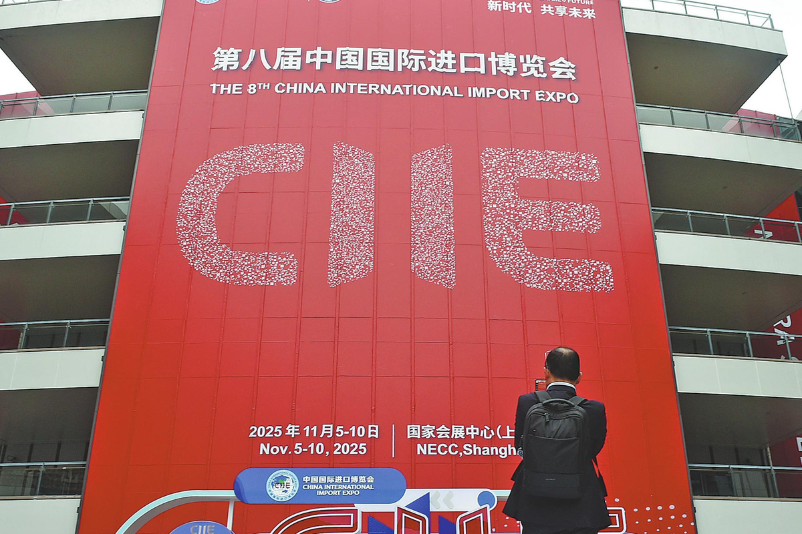Vision for shared prosperity
The recommendations for the 15th Five-Year Plan could help shape a greener, fairer era for China and other Global South countries


As the United Nations celebrates its 80th anniversary this year, the world is contemplating who will steer the next phase of global development. China has made its position clear. Through its newly proposed Global Governance Initiative — alongside the Global Development Initiative, Global Security Initiative and Global Civilization Initiative — China seeks to shape a more inclusive, sustainable global order.
In October, the 20th Central Committee of the Communist Party of China convened its fourth plenary session, adopting the Recommendations for the 15th Five-Year Plan (2026-30) for National Economic and Social Development. This document is more than a domestic policy road map; it reflects China's evolving role in global economic and environmental governance. The plan's emphasis on high-quality, green and innovative development offers enormous potential and opportunities for the Global South, including Southeast Asia and partners such as Malaysia.
The recommendations indicate that China's growth will be more sustainable, innovative and globally beneficial. It marks a shift from the era of rapid expansion to one focused on cleaner growth, industrial upgrading and open cooperation.
With this year's United Nations Climate Change Conference, or COP30, convening in Belém, Brazil, the timing couldn't have been more critical. For the Global South, China's green pivot offers transformative opportunities in three key areas.
First, as China accelerates its transition to renewable energy, smart infrastructure and clean industries, it is simultaneously exporting technology and expertise. Through the Global Development Initiative, China is already financing solar farms in Latin America and Africa, building digital infrastructure across Southeast Asia, and promoting climate-resilient agriculture in the Belt and Road countries. This approach allows developing countries to leapfrog toward greener growth paths without shouldering the full cost of technological transition.
Second, the plan's focus on industrial upgrading could help rebalance global supply chains. As China climbs toward high-end manufacturing and innovation, many other Global South countries can position themselves as complementary nodes, providing components, materials and services in a more diversified global industrial landscape.
Third, China's expanding domestic market remains a major driver of global demand. The recommendations pledge to boost consumption and further open service-related sectors to foreign participation. For exporters across Asia, Africa and Latin America, a more stable and consumption-driven Chinese economy could mean stronger trade opportunities and more resilient global growth.
At a broader level, China's emphasis on green modernization also sends a normative message: that prosperity and sustainability can go hand in hand. Through the Global Development Initiative and the Global Governance Initiative, China is offering an alternative development vision to the Global South — one that prioritizes infrastructure, technology and ecological balance over debt-driven or resource-intensive growth.
As time goes by, the Association of Southeast Asian Nations is becoming more tightly intertwined with China's trajectory. The recent upgrade of the China-ASEAN Free Trade Area 3.0, signed in Kuala Lumpur in October, adds new momentum to regional integration. The agreement expands cooperation into several major areas, including the digital economy, the green transition and supply-chain resilience.
Here, the synergy with China's 15th Five-Year Plan is clear.
China's focus on green and digital transformation directly complements the ASEAN's priorities. The CAFTA's new green-economy provisions will encourage joint development of renewable energy, carbon trading, and circular-economy initiatives. ASEAN countries with renewable resources and manufacturing capacity, such as Indonesia, Vietnam and Malaysia, are well-placed to become important partners in China's green-industrial value chains.
Meanwhile, the inclusion of digital trade and innovation aligns perfectly with China's commitment to advanced technology and connectivity. Cross-border e-commerce, artificial intelligence applications and data infrastructure can help the ASEAN's small and medium-sized enterprises expand into Chinese markets and integrate more deeply into regional digital ecosystems.
With many multinationals diversifying production beyond China, the ASEAN has become a natural extension of East Asia's manufacturing network. The CAFTA 3.0 framework reinforces this by improving customs facilitation, logistics integration and investment protection, making the region more attractive to high-quality Chinese and global investment.
Among ASEAN members, Malaysia stands out as a natural partner for China's next phase of development. The two countries share a long history of trade and cultural exchanges, now further strengthened by their collaboration under the Global Development Initiative and the Global Civilization Initiative.
Malaysia's MADANI vision — rooted in sustainability, innovation and inclusivity — aligns closely with China's vision of a shared future for humanity, emphasizing high-quality, green growth. This philosophical convergence is already translating into practical cooperation in areas such as renewable energy, digital infrastructure and industrial upgrading. Chinese investment in Malaysia's green technology and manufacturing sectors is on the rise, while Malaysian companies are increasingly tapping into China's vast consumer market and digital platforms.
The recent signing of the CAFTA 3.0 in Kuala Lumpur symbolizes Malaysia's central role in this evolving partnership. As China pushes forward with its 15th Five-Year Plan, Malaysia could emerge as both a gateway for Chinese engagement with the ASEAN countries and a model for South-South cooperation, balancing economic dynamism with cultural and environmental stewardship.
The recommendations for China's 15th Five-Year Plan arrive at a defining moment for global governance. As the world faces climate, technological and economic challenges, China's road map signals a commitment to pair growth with sustainability and openness.
For the Global South, it presents a model of green, inclusive cooperation; for the ASEAN, a pathway to deeper trade and technological integration; and for Malaysia, a chance to strengthen pragmatic and culturally rooted partnership.
Ultimately, the success of China's five-year plan hinges on its ability to translate its vision into shared progress. If pursued collectively, it could help shape a greener, fairer era of globalization led by the aspirations of the Global South.
The author is a research associate at the Malaysia-China Friendship Association and the former deputy director of the Institute of China Studies at the University of Malaya. The author contributed this article to China Watch, a think tank powered by China Daily.
The views do not necessarily reflect those of China Daily.
Contact the editor at editor@chinawatch.cn.


































